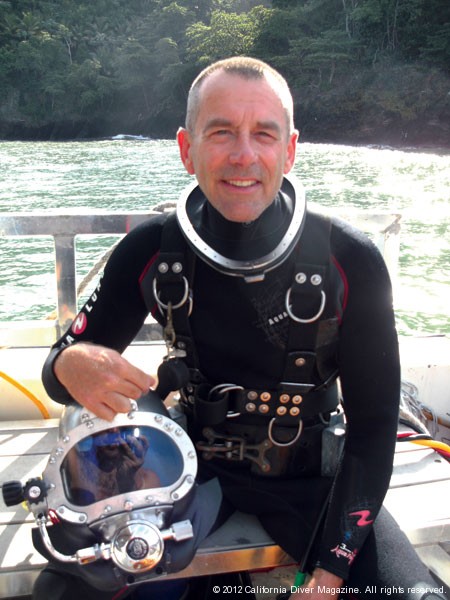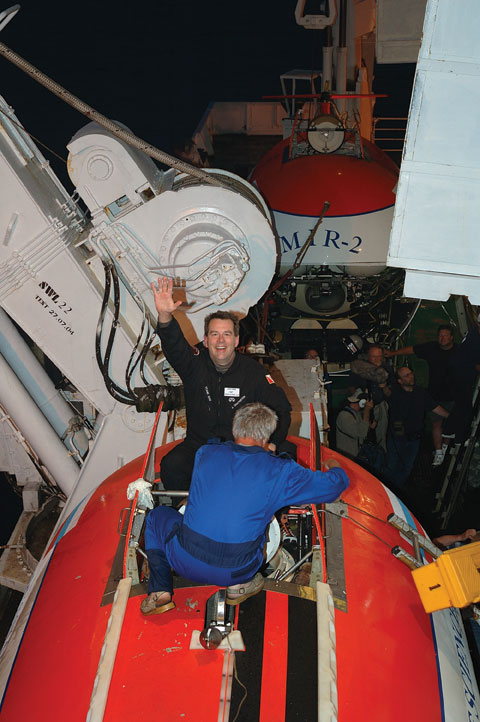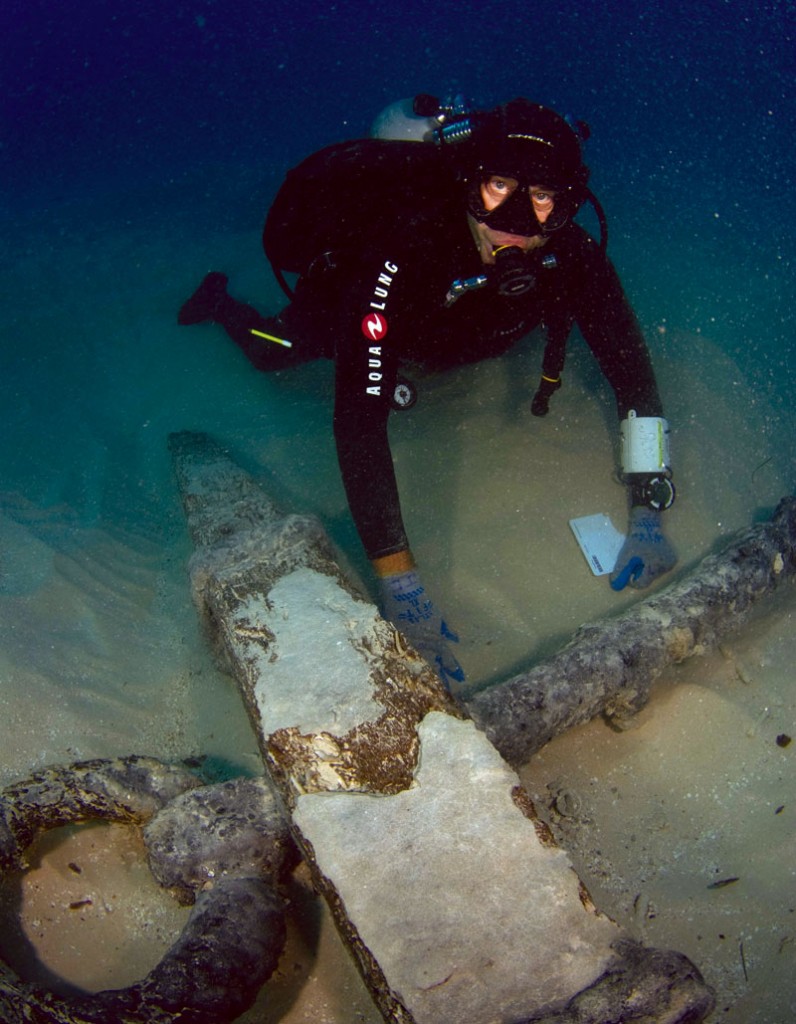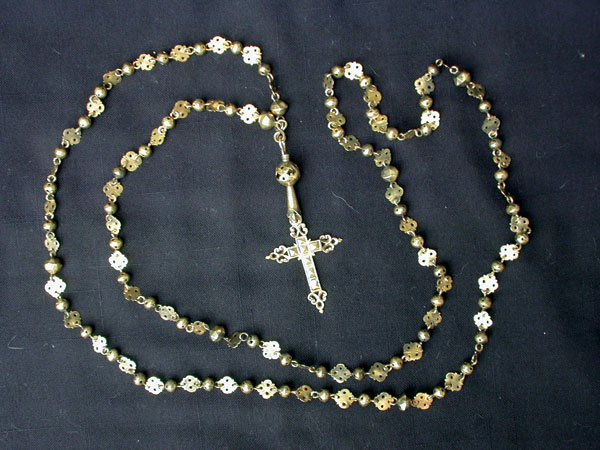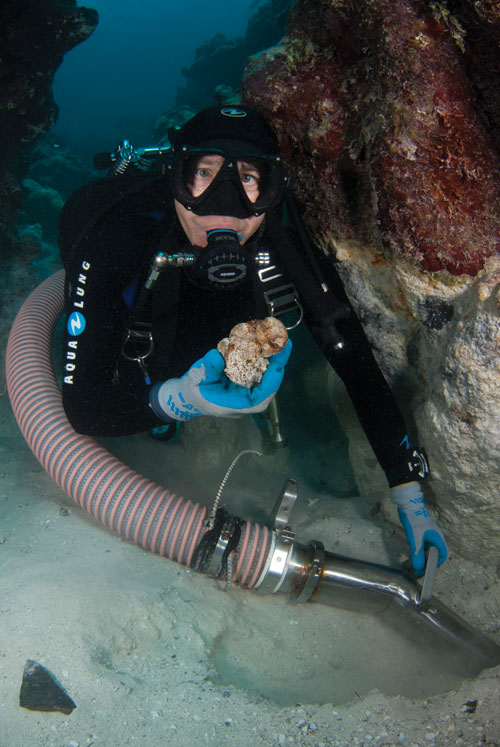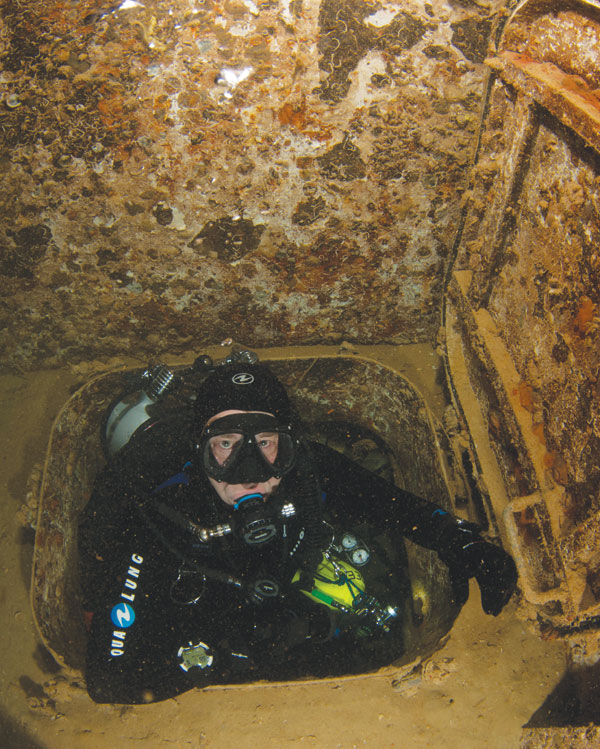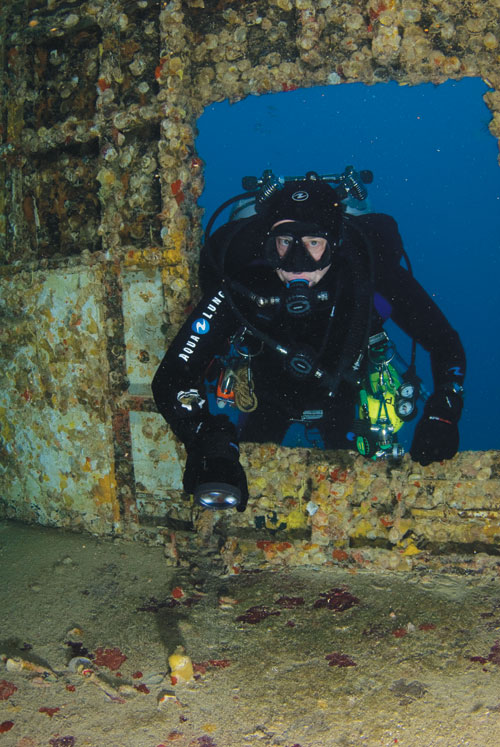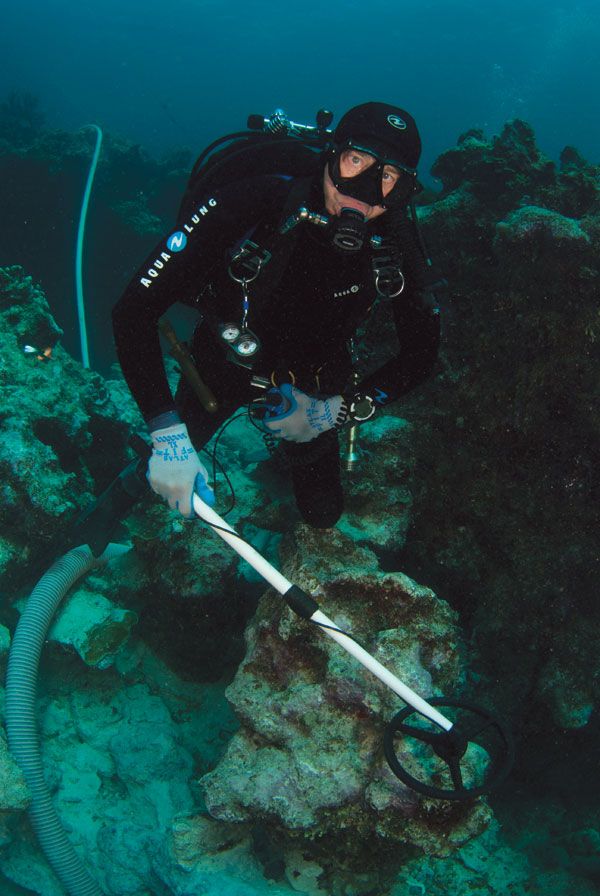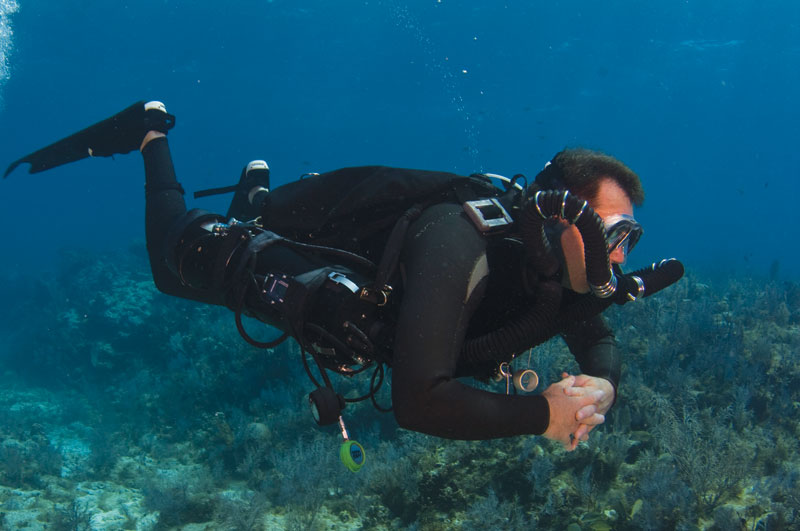John Chatterton’s name first came into the public consciousness as one of the main subjects of Robert Kurson’s bestselling book Shadow Divers. Kurson’s book, although non-fiction, reads like a novel: Chatterton and his diving buddies discover an unknown World War II German submarine (later identified as U-869) off the coast of New Jersey, kicking off a seven-year quest to identify the wreck. The team’s research takes them far beyond the library, where they pore over old Nazi U-Boat records, looking for information about a submarine that—according to official records—should not exist. Their search for the truth is marked by technical deep dives, unfathomable risks, and several deaths.
——————————————————————————————————————-
Story by Mike Bear, California Diver Science Editor. Photos as credited.
——————————————————————————————————————-
While Shadow Divers might have propelled him to international fame, John Chatterton had long been something of a celebrity within the often-insular diving community at the time of the book’s publication. A veteran of over 160 dives on the SS Andrea Doria (often described as the “Mount Everest of diving”), he had also garnered legendary status by recovering the safe of the SS Carolina.
In August 2005, Chatterton and his partners put together an expedition to the most famous shipwreck in the world, the RMS Titanic—diving to 12,500 feet in a Russian MIR submersible. He and fellow diver Richie Kohler co-hosted the History Channel’s Deep Sea Detectives, researching and filming 57 episodes. Chatterton also spent 20 years working as a commercial diver in and around New York City. He was underwater, working, on September 11, 2001—directly across the street from World Trade Tower #1—at the time of its tragic demise.
Although Chatterton has spent much of his career diving the East Coast of the United States, he has also explored California underwater, most notably Catalina Island and the oil rigs off of the coast of Southern California. At the time of this article’s publication, he had just returned from a trip to the Dominican Republic, where he was searching for shipwrecks. Despite his hectic schedule, Chatterton graciously agreed to an interview with California Diver Magazine.
California Diver: You are one of the most well-known figures in deep wreck diving today. What is it about diving shipwrecks that has held your interest over the years?
John Chatterton: When I first started wreck diving, I was fortunate enough to fall in with the “wrong crowd”—deep air wreck divers. The late Bill Nagle was the Captain of the dive boat Seeker, and he is really the guy who taught me what wreck diving was all about. He motivated and inspired me to strive to become a skilled wreck diver, using his yardstick. To Bill, diving was about going places where no one else had been. He did not have much in the way of social skills, but he was very generous in sharing what he knew about diving, as well as his genuine enthusiasm for shipwrecks and history. He sort of taught me how to excel, and how to survive.
Those are my roots. I love challenging myself, and I have never found any shortage of opportunities for new and varied challenges in wreck diving. For me, diving is still fun and interesting, because I have been able to almost continuously evolve as a diver—with changing skills, equipment, goals, and new wrecks.
California Diver: Thanks to the book Shadow Divers, you have also achieved fame for your work in locating the U-869 U-Boat. There have been rumors over the years of your story being turned into a movie. Any word on that?
John Chatterton: 20th Century Fox purchased the rights to Shadow Divers, and renewed our contract as recently as a year ago. They are trying to come up with a script that the director, the studio, and the producers all like. Apparently that is not easy, but it seems like they might now have the script. They already have made a significant investment in the project, so maybe we will be lucky and see it go into production.
California Diver: You also retrieved the safe of the SS Carolina. How did that come about?
John Chatterton: In New Jersey, the Carolina was one of those wrecks that divers dreamed about one day finding. It was a passenger liner, and it had a great history, having been sunk by a German U-boat in World War I. It had been missing since June 2, 1918, and more than a couple of Jersey divers had gone looking for it without success.
Of course, like everyone else, I wanted to find the Carolina, too. With all of the U-boat research I had done, I was already familiar with the German U-boat Archives. So I went to the original documents from WWI. On that day in 1918, the submarine U-151 sank six ships. In the boat’s KTB, or ship’s log, was a trace of their movements for that day. I assumed that it would be easier to look for all six wrecks, rather than just the one. The submarine had to use a sextant and dead reckoning for navigation. So, they could have been way off on their positioning, having come all the way across the Atlantic, but their relative positions for that particular day should be pretty close, right?
I made some fundamental assumptions about the wrecks. First, I have never been on a wreck without mono-filament fishing line on it. So I believed that someone knew where the Carolina was . . . they just did not know what it was. I was convinced that some of the local guys were fishing these sites.
I asked around the docks to find out who the fisherman was with the most experience in the general area where the wrecks were located. Everyone told me that I should talk to Paul Regula on the boat Bounty Hunter. I found Paul, and explained what I was doing. He was a smart guy, and already familiar with the history of the Carolina. He insisted he already knew where it was, and was very much interested in what I had to say. I showed him my chart overlay for the six U-151 wrecks, and we were able to align my overlay onto his chart of the wrecks he was fishing. We were immediately able to line up five of the six. He had been fishing the site I thought was the Carolina, but it was not the site he thought it was.
Paul wanted to follow through on this, and use his boat for us to dive the wreck. Brad Sheard, John Yurga, and Barb Lander joined me on the Bounty Hunter. The day we picked was absolutely beautiful, and so was the wreck, in about 240 feet of water. I made my first dive, and was convinced it was the Carolina. On my second dive, I found the brass letters across the fantail, “C-A-R-O-L-I-N-A,” and recovered the letter “C.”
On the very next trip to the wreck, I tried to swim it end to end, but I was running a little late getting back to anchor line, due to the current. I swam over a hole in the deck, and inside I saw a large metal box, with little short stubby legs. I did not have much time to check it out, because I was limited on my open-circuit gas supply, but my first impression was that it was a safe! After reviewing the ship’s deck plans, I thought it was the Purser’s safe from first class. But the offshore dive season was over.
I decided to go to court, and get the rights to the safe under Admiralty Law, before bringing it up. My case was put before Judge Joseph Rodriguez. I was not aware that Judge Rodriguez was the first Hispanic federal judge to be appointed in the state of New Jersey. He was known for giving spirited lectures to immigrants who appeared before him to take their oaths as naturalized citizens. He would tell the story of his father, who had emigrated from Cuba to America. His ship had been sunk by a German U-Boat off the coast of New Jersey. His father’s story of survival—of being adrift in an open lifeboat that traveled over 70 miles to arrive on the beach in Atlantic City—is truly inspiring.
Amazingly, it turned out that Judge Rodriguez’ father was aboard the Carolina! Later, I would bring up the safe. It contained gold, silver, diamonds, and a variety of artifacts. With a professional genealogist, I am still researching a gold wedding band with a date and two sets of initials on it. Maybe someday I will find the family to whom it belongs.
I will always have a special place in my heart for the SS Carolina. Obviously, the possibility of discovering or identifying a wreck is one of the main reasons why I dive shipwrecks. But I am especially fond of this particular wreck, because I was also able to see how the Carolina played such an important role in shaping the lives of the Rodriguez family.
California Diver: You recently worked in Hawaii with PBS on a NOVA special about the Japanese mini-subs at Pearl Harbor. What did you find about the mini-subs that was not known before? Is it true that the USS Ward may have, in fact, fired the first shots against these mini-subs, several hours before Pearl Harbor was attacked?
John Chatterton: The Japanese attack on Pearl Harbor on December 7th, 1941, was a two-pronged air and sea attack, utilizing both aircraft and submarines. There were five Midget Subs that took part in the assault. Three of these subs were accounted for at, or near, the time of the attack.
Terry Kirby and his associates at the University of Hawaii, NOAA, and Hawaii Undersea Research Lab (HURL), were able to locate the fourth sub a few years ago. The fourth sub had been sunk by the USS Ward more than an hour before the first wave of Japanese aircraft appeared over Pearl. The Navy brass did not believe the report from the Ward, and did not issue an alert. The shot fired by the Ward was the first shot fired on December 7th, 1941, and thereby the first shot fired by the US in WWII. When Terry found the wreck, the sub had a hole drilled into the sail, just as it had been described by the men on the Ward. The sub had been so close when the Ward fired, the artillery shell did not have time to arm itself to explode. It is a fascinating story, and we did an episode on it for Deep Sea Detectives.
Over the years, I kept in touch with Terry Kirby, and when he felt he was on to something about the fifth and final Midget, he called me. I helped him put together a project with NOVA and PBS. We did a program called “Killer Subs of Pearl Harbor,” where Terry and his team located the sub and put together a lot of the mystery of what happened to the Japanese Midget Submarine I-24.
As often happens with a good mystery, locating the remains of the sub raised more questions than it answered. In my mind, the foremost question is “what happened to the crew?” This is genuinely something for historians to ponder.
Terry and his crew were able to fill in some of the blanks in the history of Pearl Harbor. Personally, I was honored to dive with Terry in the Pisces submersibles from HURL, as well as make a few dives with the National Park Service on the USS Arizona—all as part of the NOVA special. I think of myself as incredibly fortunate to have been involved in this project.
California Diver: You and Kohler mounted an expedition to the RMS Titanic in 2005, aboard the Russian research ship Keldysh, for some specials on the History Channel. There are reports that the Titanic is being slowly dissolved by so-called “rusticles” that may result in the eventual destruction of that ship. Do you think anything can be done to preserve it?
John Chatterton: Most people have seen footage of Titanic sitting on the bottom of the ocean, strands of rust hanging from the bow of the wreck, looking much like icicles. They have been named “rusticles,” and scientists are only recently beginning to study them. What they have learned is that rusticles are composed of colonies of iron-eating micro-organisms, with different dominant organisms in different rusticles. It is some fascinating science, and the work of figuring out how the rusticles play into the lifecycle of ferrous shipwrecks is only beginning.
I guess we all would like to look good and live forever, wouldn’t we? However, that is not the way of nature (although some of us look better than others). It seems to me that time holds the winning hand. We are born, we age, and then we return to the soil. That is kind of the way it works with us . . . and the same is true of shipwrecks.
Face it. Shipwrecks age. As much as we might like to see Titanic live forever, that is just not the way of nature. The wreck of Titanic will continue to age, and eventually she will disappear. But I would imagine that the memory of Titanic will remain with us for far longer. Preserving the history of Titanic is important, but preserving the wreck itself forever is a fantasy.
California Diver: You also dove the HMHS Britannic, near the island of Kea in Greece, at a depth of 400 ft. on a rebreather, something that would never have been possible on regular SCUBA. What was that like?
John Chatterton: Jacques Cousteau discovered the HMHS Britannic in the 1970’s and the Cousteau team dove the wreck on open-circuit SCUBA. Their dives were of relatively short duration, but impressive for the time period. There were a couple of other open circuit expeditions as well, again, with modest bottom times.
The first time I dove the HMHS Britannic was in 1998, as part of a British expedition. Everyone on the team was diving open-circuit, except for me. I was the only rebreather diver.
As we were applying for our permits to dive the wreck, we had a meeting with the wreck’s owner, Simon Mills. Mills was an annoying little man who was not a diver and who had purchased the rights to the wreck from the previous owner. Mills liked to be in control, and I did not care for him.
He starts out the meeting by telling us that he had been talking with Dr. Ballard about the possibility of anaerobic compartments—compartments where there is no oxygen—within the wreck of Britannic. If they existed, these compartments might have been perfectly preserved. As a result, we would not be allowed to penetrate the wreck, specifically because Mills and Ballard concluded the diver’s bubbles would disrupt these anaerobic compartments, thereby damaging the wreck.
I was just a simple commercial diver, but I know Ballard does not like wreck divers, and I know that water is made of hydrogen and oxygen. This stunk like phony science to me, and I thought it was total BS. I did not like Mills telling me what I could and could not do. And to tell the truth, when it comes to big steel wrecks, I am kind of an inside guy. I was truly not happy.
So, I interrupt Mills, and ask him, what about me, a rebreather diver who does not make bubbles? He inquired as to what a rebreather was, and I explained it was an apparatus that contained a closed breathing loop, where the diver’s exhaled gas is cycled through a chemical absorbent that removed the CO2, and the oxygen metabolized by the diver is replaced by an electronic system that sensed oxygen levels and added oxygen as it was needed.
Mills was kind of caught off-guard, and had to think for a few seconds. “Fine, we will amend the permit. John Chatterton is the only diver permitted to penetrate the wreck using a rebreather, but the other divers will not be allowed inside.
I felt like I had beat Mills at his own game, but at the time, I did not even have a rebreather and had no real experience diving one—especially in the neighborhood of 400 feet. Regardless, I was committed, and now I had to deliver. My choices were somewhat limited and I was in a hurry. Although there were a few display rebreather units at the dive shows, they were like “vaporware.” At the time, there were no commercially manufactured rebreathers for wreck diving. The only unit I could lay my hands on was a prototype of an AURA CCR2000.
I flew to Seattle to conduct my training in Puget Sound. My two certification dives amounted to a total of about eight minutes of bottom time, because I had catastrophic loop failures on both dives. I left Seattle with a suitcase full of parts, and not much else, so I had a lot of work to do. I estimate I had 40 dives with serious system failures, before I had three dives in a row where nothing bad happened. Those were my last three dives before leaving for Britannic. On Britannic, I made a total of six dives, and had rebreather failures on three of them, where I had to bail to open circuit. The electronics caught fire in my hotel room the night before one dive, and on another day I had to fix the onboard computer with a soldering iron. Back then, diving rebreathers was a little more adventurous. However, I was the first diver to use a rebreather on Britannic. I penetrated the wreck, and I did not see any mythical anaerobic compartments. Seriously, I looked.
I returned to the wreck in 2006, leading an expedition with Richie Kohler for the History Channel. All of the bottom divers were on rebreathers. What a difference eight years makes! We conducted dives with bottom times as long as 40 minutes, and runtimes of over seven hours. Dives that long are really only possible on rebreathers.
California Diver: There have also been reports that the Andrea Doria is deteriorating and collapsing. Is it still worth being called the “Mount Everest” of wreck diving?
John Chatterton: I have seen Everest, but never climbed it. From what little I see on TV, it is a popular destination for serious tourist climbers. Obviously, it is still a formidable climb—and dangerous—but there are plenty of professional guides looking for clients, the routes are well known, and the equipment and technology is pretty well evolved enough to help climbers manage the inherent risks of high-altitude climbing. It seems to me that Everest is just not as tall as it used to be.
The thing that made the Doria such an imposing wreck years ago, was not just the depth, but that it afforded divers the opportunity for deep, complex, multi-deck penetrations. We memorized the ship’s deck plans, and that was how we navigated around inside. The fact that the wreck was so deep, the water was cold, there were strong currents, and divers were using air, all made it extremely challenging.
You are right, the Doria isdeteriorating. The wreck is compressing, collapsing on itself, and as a result, it no longer offers the kind of penetrations it once did. At the same time, divers are able to utilize Trimix, or, more often, rebreathers, to conduct their dives. The Doria is not the wreck it once was, and it is not as deep as it used to be, at least not figuratively.
Make no mistake about it: the Doria is still an extremely serious dive. As recently as this past summer, a diver lost his life on the wreck. The deep-water wrecks of the North Atlantic do not tolerate mistakes very well. Maybe the comparison to Mount Everest is a fair one . . . but that is only if you consider that the Doria is not what it used to be, and neither is Everest. This is just my opinion.
California Diver: You’ve been in the Dominican Republic recently. What were you working on?
John Chatterton: I have been working in the Dominican Republic for several years. My partners and I have a contract with the Dominican Government to locate, document, and salvage shipwrecks of interest. We work closely with Dominican Navy, and the Oficina Nacional de Patrimonio Cultural Sub Acuático.
Diving blue water, looking for colonial-era shipwrecks, mostly in remote, shallow reef systems, is relatively new for me. The challenges doing what I do now are completely different from those I faced while I was diving big steel wrecks. These days I struggle with speaking Spanish, keeping my magnetometer and side-scan sonar off the rocks, and making the Nitrox machine work. This is while we dodge hurricanes and try to keep our boats afloat. Every day is new challenges and new opportunities. But that has been true of my entire diving career.
Over the years, I have been allowed to reinvent myself as a commercial diver, a deep-air diver, a scuba instructor, a Trimix diver, a rebreather diver, an ROV operator, a TV diver, a submersible diver, and now I am working as a commercial archaeologist.
Seriously, I started out shore diving in Florida with a single tank and crappy rental gear, and look at me now. I don’t even have a college degree, but I have been to Titanic. I am 60 years old, and on any given day I may jump in the water on SCUBA, dive a full-face mask, or even work at the end of an umbilical in my KM37SS hardhat. Today, I am going to go looking for a new shipwreck, and I just I might find one. I feel great, but I am so excited I have trouble sleeping at night! This is exactly why I love diving shipwrecks. I never run out of things to do.
California Diver: California has some decent wreck diving, including the former HMCS Yukon, a 366-foot-long Canadian warship, which now belongs to the city of San Diego, off Mission Beach. Have you ever dived it? You are welcome to come dive it with us any time.
John Chatterton: Sure. I love diving on the “Left Coast,” and I will take you up on that the next time I am in town. I will also extend an offer for you guys to come over and dive with us here in the DR. But if you come, be ready to work!
Story by Michael Bear, photos above as credited.
Michael Bear is a PADI Divemaster with over 1,000 cold water dives in California and has been diving in the San Diego area for over a decade. He is also an active Science Diver with the American Academy of Underwater Sciences (AAUS) and founder of the Sevengill Shark Sightings website. He lives and works in San Diego.
All copy and photos are © Copyright 2014 by California Diver Magazine and the original photographers credited above. Copying or any reproduction of this content is strictly prohibited without prior express written permission. All rights are reserved.

